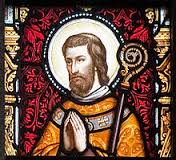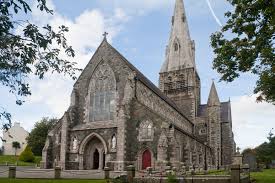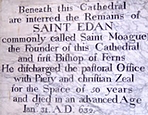
Summary : St Aidan. An inscription on the wall of the Church of Ireland (Anglican) Cathedral of St Aidan in Ferns, Co Wexford, tells of his burial place.
Patrick Duffy tells what is known about Aidan and the diocese.
Many Irish saints have an intimate form to their name and Aidan, or, as he is also called, Mogue, is a case in point. Mogue is derived from the Irish Mo Aodh Óg (= “my young Aodh” or “my darling Aodh”). Ferns (Fearna, the alder tree), where he set up his church, became his episcopal seat.
Born on Inis Breachmhaigh, Templeport Lake, C o.Covan
Aidan was born in Inis Breachmhaigh, now known as Port, Inch or Mogue’s Island, in Templeport Lake, near Bawnboy in County Cavan, around 550. Both his father Setna and his mother Eithne were of noble origin. There was no boat to take the infant to the mainland to be baptised, so he is said to have been miraculously floated across the lake on a slab of stone to where Saint Kilian was waiting to baptise him. The parish church of Templeport parish (St. Mogue’s Church in Bawnboy) in the diocese of Kilmore is called after him and the church’s holy water font is said to be made from part of that stone.
Studies at Clonard and in Wales
As a small boy, Aidan was held as a hostage by the High King of Ireland, Áedh MacAinmuirech, of the Cenél Conaill, probably to insure the loyalty of his family. When he was released, Aidan studied to become a monk under St Finnian of Clonard, where he made friends with St Molaise, who would later found the monastery of Devenish Island on the River Erne. From Clonard Aidan went to study under St David at Kilmuine (Cil-mynyw) in Wales. During his time here David placed him in charge of a church at Llawhaden (pronounced LLAN-HAUA-DEN) in the hundred (county sub-division) of Dungleddy in the centre of Pembrokeshire, where a church remains dedicated to him to this day.

Saint Edan’s Cathedral, Ferns … the saint became Bishop of Ferns in 598, a year after Saint Augustine became Archbishop of Canterbury
Return to Ireland
In 580, Aidan returned to Ireland, going to the coast of Wexford. Here he served in the area around Ferns. In 598 Brandubh, king of the Uí Cinsealaigh in Leinster, defeated and killed King Áedh MacAinmuirech at the Battle of the Pass of Dunbolg (near Holywood, Co Wicklow). Brandubh called a celebratory synod at which he elevated Ferns to the status of a diocese and made Aidan its first bishop giving him nominal supremacy (Ard-Escops or chief bishop) over the other bishops of the region.
Lives of St Aidan
The written Lives of St Aidan tell of many miracles showing his generosity and kindness. One story tells how some spurious beggars hid their clothes, dressed in rags, and asked Aidan for help; knowing what they had done, Aidan gave away their clothes to some more deserving poor, and sent off the imposters with neither clothes nor alms.
Other stories tell of feats of austerity, such as fasting on barley bread and water for seven years, as well as reciting 500 Psalms daily.
Other Monasteries in Cavan, Waterford and Leitrim
Other monasteries were said to have been founded by Aidan at Drumlane, near Milltown, Co Cavan; at Dísert-Nairbre in County Waterford; and at Rossinver on Lough Melvin’s shore in County Leitrim, where he died on the 31 January 632. He was said to have been buried in the church that he had established there. A bronze reliquary in which his relics were kept is currently preserved in Dublin.
The Diocese of Ferns
 One of Aidan’s successors, St Moling (died 679 – feast 17th June), dedicated a holy well at Ferns in memory of its founder, now known as Maodhóg’s Well. During the 9th and 10th centuries the monastery at Ferns was raided and burned by the Vikings on at least eight occasions before they eventually converted to Christianity. In 1111 the boundaries of the diocese were defined by the Synod of Rath Breasail. In 1158 Dermot McMurrough founded an Augustinian abbey in Ferns and had Ferns as his capital. Ferns Cathedral was built in the 13th century
One of Aidan’s successors, St Moling (died 679 – feast 17th June), dedicated a holy well at Ferns in memory of its founder, now known as Maodhóg’s Well. During the 9th and 10th centuries the monastery at Ferns was raided and burned by the Vikings on at least eight occasions before they eventually converted to Christianity. In 1111 the boundaries of the diocese were defined by the Synod of Rath Breasail. In 1158 Dermot McMurrough founded an Augustinian abbey in Ferns and had Ferns as his capital. Ferns Cathedral was built in the 13th century  within the boundary of the monastery founded by St Aidan, probably by John St John, the first English bishop of Ferns, who died in 1243. In 1539 with the suppression of the monasteries it passed to the Church of Ireland. The remains of St Aidan or Mogue are said to be buried underneath the Church. An inscription on the wall states that he died on 31st January 632 (see image above). In the years after Catholic Emancipation a new Catholic cathedral in honour of St Aidan designed by A.W.N. Pugin was built in Enniscorthy, which then became the Catholic episcopal seat.
within the boundary of the monastery founded by St Aidan, probably by John St John, the first English bishop of Ferns, who died in 1243. In 1539 with the suppression of the monasteries it passed to the Church of Ireland. The remains of St Aidan or Mogue are said to be buried underneath the Church. An inscription on the wall states that he died on 31st January 632 (see image above). In the years after Catholic Emancipation a new Catholic cathedral in honour of St Aidan designed by A.W.N. Pugin was built in Enniscorthy, which then became the Catholic episcopal seat.
_______________
******************************
Memorable Proverbs for today
The goal of a good pastor
is to raise up good pastors;
~Francis Khan~
**********************************